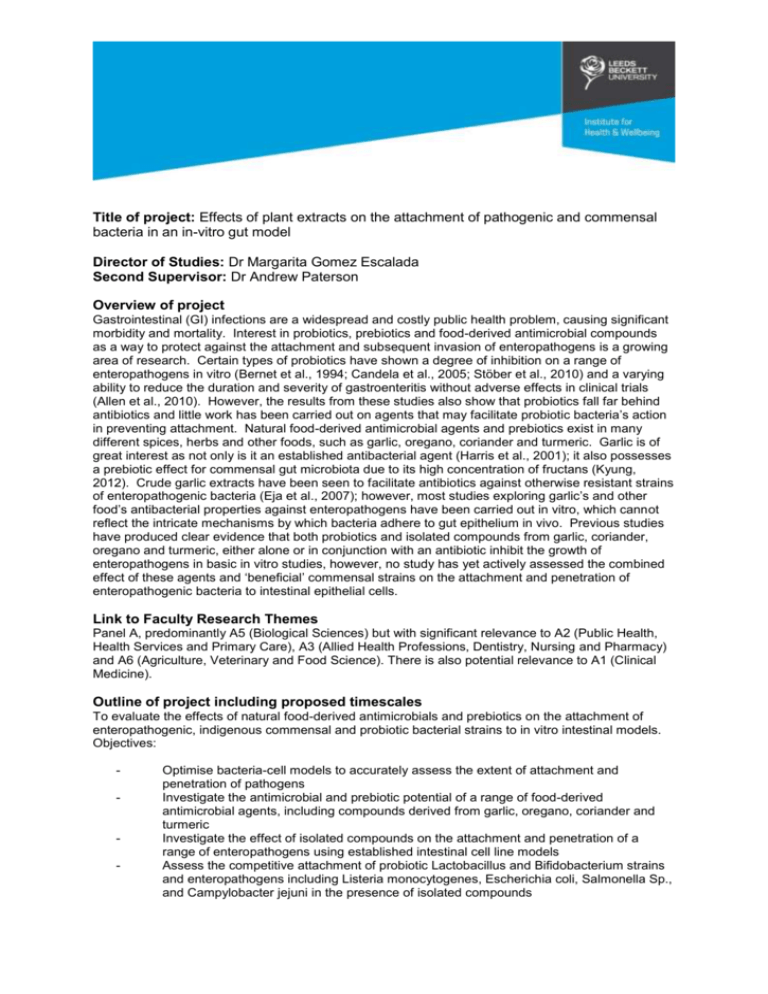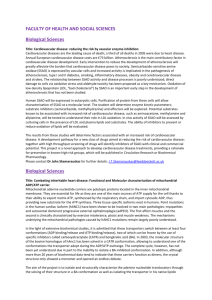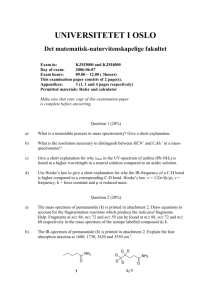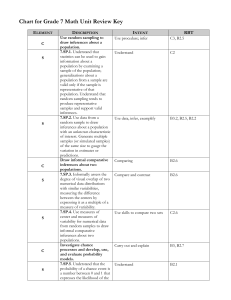Effects of plant extracts on the attachment of pathogenic and
advertisement

Title of project: Effects of plant extracts on the attachment of pathogenic and commensal bacteria in an in-vitro gut model Director of Studies: Dr Margarita Gomez Escalada Second Supervisor: Dr Andrew Paterson Overview of project Gastrointestinal (GI) infections are a widespread and costly public health problem, causing significant morbidity and mortality. Interest in probiotics, prebiotics and food-derived antimicrobial compounds as a way to protect against the attachment and subsequent invasion of enteropathogens is a growing area of research. Certain types of probiotics have shown a degree of inhibition on a range of enteropathogens in vitro (Bernet et al., 1994; Candela et al., 2005; Stöber et al., 2010) and a varying ability to reduce the duration and severity of gastroenteritis without adverse effects in clinical trials (Allen et al., 2010). However, the results from these studies also show that probiotics fall far behind antibiotics and little work has been carried out on agents that may facilitate probiotic bacteria’s action in preventing attachment. Natural food-derived antimicrobial agents and prebiotics exist in many different spices, herbs and other foods, such as garlic, oregano, coriander and turmeric. Garlic is of great interest as not only is it an established antibacterial agent (Harris et al., 2001); it also possesses a prebiotic effect for commensal gut microbiota due to its high concentration of fructans (Kyung, 2012). Crude garlic extracts have been seen to facilitate antibiotics against otherwise resistant strains of enteropathogenic bacteria (Eja et al., 2007); however, most studies exploring garlic’s and other food’s antibacterial properties against enteropathogens have been carried out in vitro, which cannot reflect the intricate mechanisms by which bacteria adhere to gut epithelium in vivo. Previous studies have produced clear evidence that both probiotics and isolated compounds from garlic, coriander, oregano and turmeric, either alone or in conjunction with an antibiotic inhibit the growth of enteropathogens in basic in vitro studies, however, no study has yet actively assessed the combined effect of these agents and ‘beneficial’ commensal strains on the attachment and penetration of enteropathogenic bacteria to intestinal epithelial cells. Link to Faculty Research Themes Panel A, predominantly A5 (Biological Sciences) but with significant relevance to A2 (Public Health, Health Services and Primary Care), A3 (Allied Health Professions, Dentistry, Nursing and Pharmacy) and A6 (Agriculture, Veterinary and Food Science). There is also potential relevance to A1 (Clinical Medicine). Outline of project including proposed timescales To evaluate the effects of natural food-derived antimicrobials and prebiotics on the attachment of enteropathogenic, indigenous commensal and probiotic bacterial strains to in vitro intestinal models. Objectives: - - Optimise bacteria-cell models to accurately assess the extent of attachment and penetration of pathogens Investigate the antimicrobial and prebiotic potential of a range of food-derived antimicrobial agents, including compounds derived from garlic, oregano, coriander and turmeric Investigate the effect of isolated compounds on the attachment and penetration of a range of enteropathogens using established intestinal cell line models Assess the competitive attachment of probiotic Lactobacillus and Bifidobacterium strains and enteropathogens including Listeria monocytogenes, Escherichia coli, Salmonella Sp., and Campylobacter jejuni in the presence of isolated compounds - Evaluate the role of agents protecting or enhancing commensal gut microflora and the combined effect this has on enteropathogen establishment and attachment to gut models This will be the first study to investigate the facilitation of commensal and probiotic strains with specific agents to prevent proliferation, attachment and penetration of enteropathogenic bacteria. It will direct and focus the research evaluating the potential of non-antibiotic prophylactic alternative for bacterial gastroenteritis potentially leading to novel therapeutic pro-biotic interventions. Methods The gut model proposed is based on a cell culture system of epithelia from the small and large intestine. Caco-2 and HT29, cell lines from the small and large intestine respectively, have been selected as they differentiate forming tight junctions and in the case of HT29 cells express goblet cells which produce mucin. Characteristics of the model such as permeability of the epithelial layer will be determined. The models developed provide a system in which attachment of specific bacterial strains to human gut epithelium can be assessed. Common invasive enteropathogens such as Salmonella sp., Escherichia coli, Listeria monocytogenes and Campylobacter sp. will be assessed, as this will allow the study of different mechanisms of attachment and invasion. Quantification of cell attachment will be carried out by the counting of attached bacteria. The nature of attachment will be determined by atomic force microscopy (AFM). Garlic has already been shown to have an effect on the attachment of Salmonella thompson utilising a CaCo-2 gut model (Sinclair et al., in preparation). There are a number of other plant extracts that could have similar activity, which include oregano, coriander, turmeric all of which are herbal in origin and hence food-grade extracts can be obtained. The model will provide a system in which the effects of such phytochemicals upon attachment of specific bacterial species can be assayed within this project. Strains such as Lactobacillus acidophilus and Bifidobacterium breve have both shown to adhere to CaCo-2 cells and inhibit enteropathogenic bacteria to some degree (Bernet et al., 1994; Candela et al., 2005; Stöber et al., 2010). Further tests will be carried out to determine the plant extracts previously tested enhance their inhibiting effect on pathogen attachment. The proposed project will yield novel data and involve development of new methodologies/models appropriate for dissemination via scientific conferences and scientific journals thereby making it suitable as a PhD level project. The supervisory team brings together staff with expertise relating to distinct disciplines - microbiology and to development of cell culture models, and as such the student will provided with a high-quality training environment to develop as a an independent researcher over the course of the project. The range of techniques required within the project will provide the student with a skill set which will be an asset towards securing future employment following completion of the project. References Allen SJ. Jordan S. Storey M. Thornton CA. Gravenor M. Garaiova I. Plummer SF. Wang D. Morgan G. (2010) ‘Dietary supplementation with lactobacilli and bifidobacteria is well tolerated and not associated with adverse events during late pregnancy and early infancy.’ Journal of Nutrition 140: 484-8 Bernet MF. Brassart D. Neeser JR. Servin AL. (1994) ‘Lactobacillus acidophilus LA 1 binds to cultured human intestinal cell lines and inhibits cell attachment and cell invasion by enterovirulent bacteria’ GUT 35:483-9 Candela M. Seibold G. Vitali B. Lachenmaier S. Eikmanns BJ. Brigidi P. (2005) ‘Real-time PCR quantification of bacterial adhesion to Caco-2 cells: Competition between bifidobacteria and enteropathogens’ Research in Microbiology 156:887-95 Eja ME. Asikong BE. Abriba C. Arikpo GE. Anwan EE. Enyi-Idoh KH. (2007) ‘A comparative assessment of the antimicrobial effects of garlic (Allium sativum) and antibiotics on diarrheagenic organisms.’ The Southeast Asian Journal of Tropical Medicine and Public Health 38: 343-8 Harris JC. Cottrell SL. Plummer S. Lloyd D. (2001) ‘Antimicrobial properties of Allium sativum (garlic).’ Applied Microbiology and Biotechnology 57: 282-6 Kyung KH. (2012) ‘Antimicrobial properties of allium species.’ Current Opinions in Biotechnology 23: 142-7 Sinclair, R., Stafford, S., Paterson, A., & Gomez Escalada, M. Garlic compounds modulate attachment of Salmonella sp. to in vitro model of the human gut epithelium: potential as pre-biotics. Article in preparation Stöber M. Maier E. Schmidt H. (2010) ‘Protective effects of Lactobacilli, Bifidobacteria and Staphylococci on the infection of cultured HT29 cells with different enterohemorrhagic Escherichia coli serotypes are strain-specific’ International Journal of Food Microbiology 144:133-40 Further information To apply you must be eligible for NHS Continuing Professional Development (CPD) funding and have the support of your line manager in writing. General enquiries should be directed by email to the Faculty Research Director r.hogston@leedsbeckett.ac.uk to discuss the project further please contact the Director of Studies http://www.leedsbeckett.ac.uk/staff/margarita-gomez-escalada/ Applications should be made on line here http://www.leedsbeckett.ac.uk/research/research-degrees/research-studentships-andfees-only-bursaries/






